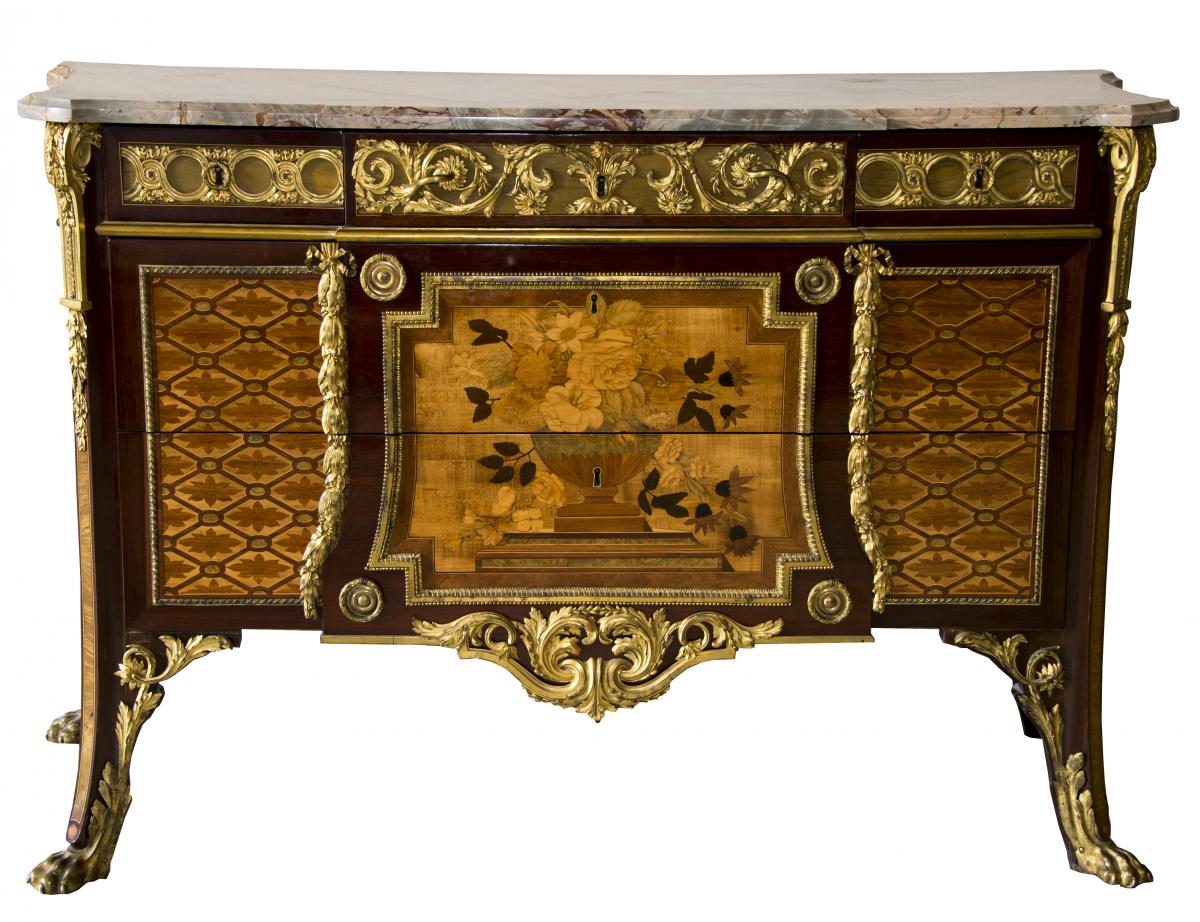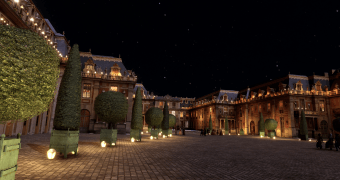A remarkable commode by Jean-Henri Riesener (1734-1806), made for Madame Adélaïde in 1776, has been acquired thanks to the Friends of Versailles Society, in the latter’s biggest patronage effort since its foundation. Its return to the Palace of Versailles, from 13 September 2018, to its exact former location in the private chamber used by Madame Adélaïde, Louis XV’s daughter and Louis XVI’s aunt, comes as part of the active refurnishing policy implemented by Versailles for many years.
Acquisition of a Riesener masterpiece
The commode
Ordered from Jean-Henri Riesener on 5 October 1776 by the Royal Furniture Treasury, the commode was delivered on 18 December 1776 with the number 2881, which is still marked on the rear panels. It is described thus: “A marquetry commode measuring 4 feet 2 inches wide, 22 inches deep and 34 inches high with a top in veined white marble, and five lockable drawers. The centre of the front depicts a heliotrope vase filled with flowers on a background of grey satin, decorated with ornaments, frames, consoles, chutes, leaves, mouldings and garlands; the whole in chased bronze gilded with gold paste”.
Crafted to a rich design, with lozenge-shaped marquetry and colours, it was among the first pieces that Riesener made for the royal family, after his nomination, in 1774, as cabinetmaker to the Royal Furniture Treasury. In 1776 he made three commodes of this type for members of the royal family. Its appealing design resides in the strength of its structure, the elegance of its bronze and the interplay of its woods. Its coloured marquetry is based on a highly structured latticework design. The ovals separating the lozenge shapes were coloured blue while the centres of the lozenges contain sunflowers, a motif dear to Riesener. The marquetry of the central panel decorated with vases of flowers comes from one of the two sources of inspiration generally used by the cabinetmaker, which alternate between allegorical trophies and pastoral subjects. Finally, the commode is remarkable for the intricacy of its bronze work, of very high quality, and its movement, as seen in the chutes surrounding the central panel which elegantly accompany and underline the structure of the piece using methods developed by the famous cabinetmaker.
Commode by Jean-Henri Riesener ©Didier Saulnier
its history
The commode was intended for the princess's private chamber in the apartment that she had occupied since 1769 on the ground floor of the central section of the Palace of Versailles, opening onto the north terrace. Unlike the grand chamber, a ceremonial room furnished according to etiquette, the private chamber was one of the private spaces in the royal and princely apartments, enabling us to discover the occupants’ personal tastes.
The commode was later sent to the Château of Bellevue, a country retreat that King Louis XVI made available to his aunts in 1774. It was placed in the first-floor apartments and stayed there until the Revolution. Sold in 1795, it was transported to England at an unknown date. Here, it appeared in the collections of Lord Carnarvon (1866-1923) before, a few decades later, becoming the property of Juan Guillermo de Beistegui, its last owner. He always loved the Palace and was a Benefactor of the Friends of Versailles Society for many years.
The acquisition of this exceptional commode was financed by the Friends of Versailles Society thanks to bequests from Simone Baraille, Micheline Cavallo and Monique Genneret. We would like to pay a particular tribute to the memory of Simone Baraille who bequeathed her entire fortune to the Friends of Versailles Society to contribute to refurnishing the Palace of Versailles.

Virtual exhibition
Sciences at Versailles
Discover the virtual exhibition "Sciences at versailles". Many of the most acclaimed scientists were part of the Court, and others came to Versailles for the ultimate honour of performing a demonstration for the king, the equivalent of a Nobel Prize.

Virtual reality
Experience Versailles
The Palace of Versailles is offering a virtual reality experience with the application “Experience Versailles”, created with Fondation Orange, which allows visitors to relive the visit by the Ambassador of Siam to the Court of Louis XIV in 1686 and the Yew Ball held by Louis XV.




